Review of Predictive Methodology for Diabetic Data Analysis
VerifiedAdded on 2023/04/03
|9
|1752
|427
Literature Review
AI Summary
This literature review explores the application of predictive data analysis in managing and predicting diabetic mellitus (DM) complications using big data. It highlights the challenges in the healthcare industry, such as insufficient physicians and low health insurance coverage, which necessitate digital methodologies for data analysis. The review covers various techniques employed to process and analyze diabetic data, including clinical records, electronic health reports, and diagnostic records. It emphasizes the importance of predictive models in identifying and addressing diabetic conditions early on, reducing healthcare costs, and improving patient outcomes. The analysis also discusses the use of statistical tools like regression and data mining approaches, such as the C 4.5 model, for predicting diabetic risks and prescribing appropriate treatments. The review concludes that predictive data analysis offers a promising approach for enhancing medical care, particularly in remote areas, by enabling early detection and cost-effective treatment of diabetes.

Predictive Methodology for Diabetic
Analysis in Big Data
Surname
Affiliation
Abstract
The modern health sector involves a
number of activities for processing
data and keeping the health records
of the patients. However, the health
industry is highly improving in terms
of the structures that are required for
improving the health sector.
Arguably, the health care industry
faces several challenges such as lack
of enough physicians; challenge the
information technology data records
and low health insurance issues [12].
These challenges make the health
industry to explore and develop
various methodologies for the
analysis of the data. Diabetic health
challenge known as Diabetic Health
Mellitus challenges various countries
including the developed countries
since it is a non-communicable
disease. Diabetic health mellitus is
associated with various
complications such as health
disorders. In this research study,
predictive data analysis for diabetics
shall be used for the estimation and
prediction of the prevalent DM
complications related to the kind of
treatments that shall be applied [10].
Basing on the system the treatment
for diabetic provides an efficient
approach for caring for three patients.
Introduction
In a recent study, health care
institutions have generated very large
information concerning diabetic data
analysis. However, the modern health
care industries have opted for a
digital way of keeping the
information and treatment techniques
by making use of computers.
Diabetic health care data analysis
includes clinical records, electronic
health care reports, the doctor’s
records; patient’s images,
Analysis in Big Data
Surname
Affiliation
Abstract
The modern health sector involves a
number of activities for processing
data and keeping the health records
of the patients. However, the health
industry is highly improving in terms
of the structures that are required for
improving the health sector.
Arguably, the health care industry
faces several challenges such as lack
of enough physicians; challenge the
information technology data records
and low health insurance issues [12].
These challenges make the health
industry to explore and develop
various methodologies for the
analysis of the data. Diabetic health
challenge known as Diabetic Health
Mellitus challenges various countries
including the developed countries
since it is a non-communicable
disease. Diabetic health mellitus is
associated with various
complications such as health
disorders. In this research study,
predictive data analysis for diabetics
shall be used for the estimation and
prediction of the prevalent DM
complications related to the kind of
treatments that shall be applied [10].
Basing on the system the treatment
for diabetic provides an efficient
approach for caring for three patients.
Introduction
In a recent study, health care
institutions have generated very large
information concerning diabetic data
analysis. However, the modern health
care industries have opted for a
digital way of keeping the
information and treatment techniques
by making use of computers.
Diabetic health care data analysis
includes clinical records, electronic
health care reports, the doctor’s
records; patient’s images,
Paraphrase This Document
Need a fresh take? Get an instant paraphrase of this document with our AI Paraphraser
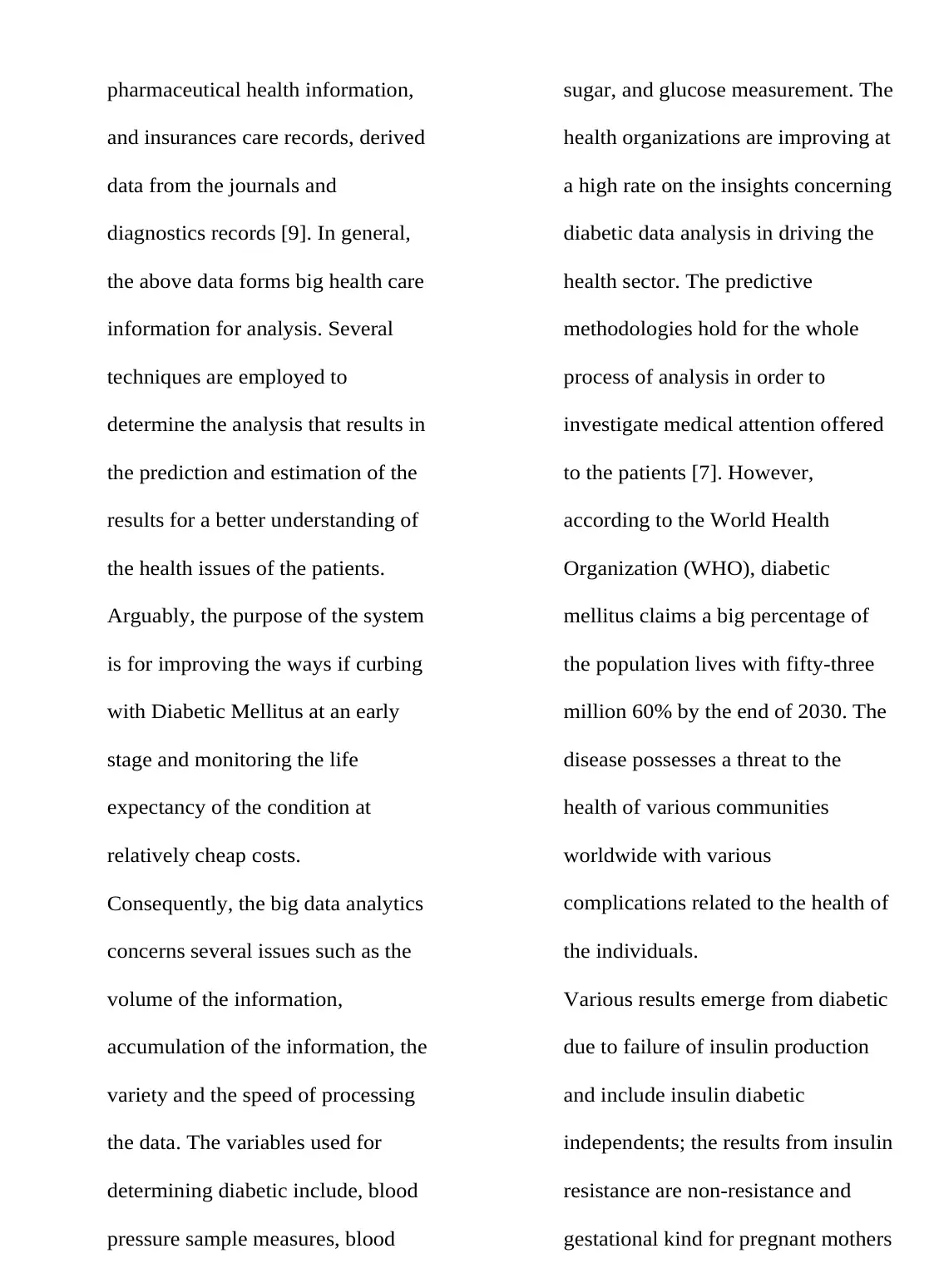
pharmaceutical health information,
and insurances care records, derived
data from the journals and
diagnostics records [9]. In general,
the above data forms big health care
information for analysis. Several
techniques are employed to
determine the analysis that results in
the prediction and estimation of the
results for a better understanding of
the health issues of the patients.
Arguably, the purpose of the system
is for improving the ways if curbing
with Diabetic Mellitus at an early
stage and monitoring the life
expectancy of the condition at
relatively cheap costs.
Consequently, the big data analytics
concerns several issues such as the
volume of the information,
accumulation of the information, the
variety and the speed of processing
the data. The variables used for
determining diabetic include, blood
pressure sample measures, blood
sugar, and glucose measurement. The
health organizations are improving at
a high rate on the insights concerning
diabetic data analysis in driving the
health sector. The predictive
methodologies hold for the whole
process of analysis in order to
investigate medical attention offered
to the patients [7]. However,
according to the World Health
Organization (WHO), diabetic
mellitus claims a big percentage of
the population lives with fifty-three
million 60% by the end of 2030. The
disease possesses a threat to the
health of various communities
worldwide with various
complications related to the health of
the individuals.
Various results emerge from diabetic
due to failure of insulin production
and include insulin diabetic
independents; the results from insulin
resistance are non-resistance and
gestational kind for pregnant mothers
and insurances care records, derived
data from the journals and
diagnostics records [9]. In general,
the above data forms big health care
information for analysis. Several
techniques are employed to
determine the analysis that results in
the prediction and estimation of the
results for a better understanding of
the health issues of the patients.
Arguably, the purpose of the system
is for improving the ways if curbing
with Diabetic Mellitus at an early
stage and monitoring the life
expectancy of the condition at
relatively cheap costs.
Consequently, the big data analytics
concerns several issues such as the
volume of the information,
accumulation of the information, the
variety and the speed of processing
the data. The variables used for
determining diabetic include, blood
pressure sample measures, blood
sugar, and glucose measurement. The
health organizations are improving at
a high rate on the insights concerning
diabetic data analysis in driving the
health sector. The predictive
methodologies hold for the whole
process of analysis in order to
investigate medical attention offered
to the patients [7]. However,
according to the World Health
Organization (WHO), diabetic
mellitus claims a big percentage of
the population lives with fifty-three
million 60% by the end of 2030. The
disease possesses a threat to the
health of various communities
worldwide with various
complications related to the health of
the individuals.
Various results emerge from diabetic
due to failure of insulin production
and include insulin diabetic
independents; the results from insulin
resistance are non-resistance and
gestational kind for pregnant mothers
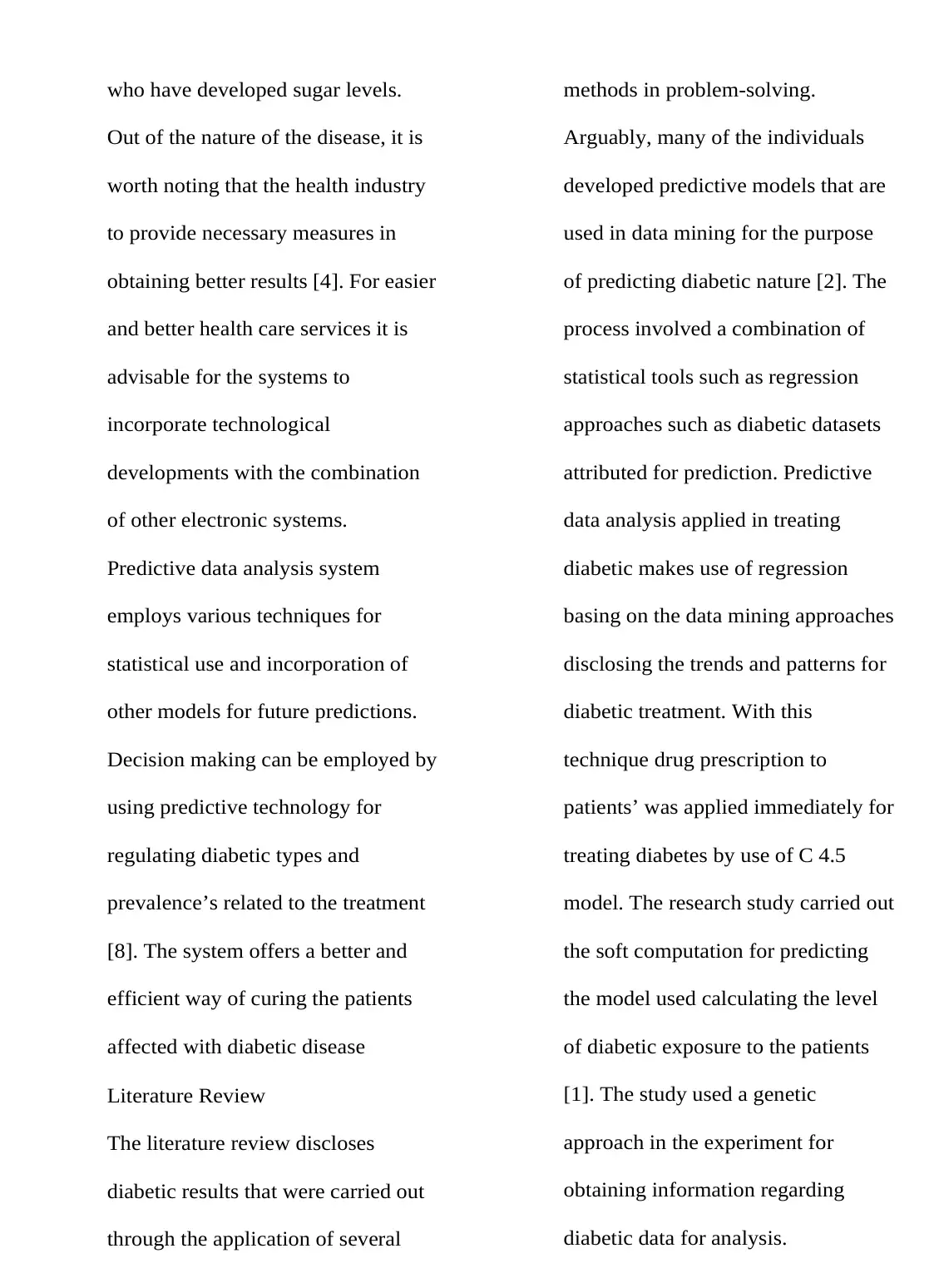
who have developed sugar levels.
Out of the nature of the disease, it is
worth noting that the health industry
to provide necessary measures in
obtaining better results [4]. For easier
and better health care services it is
advisable for the systems to
incorporate technological
developments with the combination
of other electronic systems.
Predictive data analysis system
employs various techniques for
statistical use and incorporation of
other models for future predictions.
Decision making can be employed by
using predictive technology for
regulating diabetic types and
prevalence’s related to the treatment
[8]. The system offers a better and
efficient way of curing the patients
affected with diabetic disease
Literature Review
The literature review discloses
diabetic results that were carried out
through the application of several
methods in problem-solving.
Arguably, many of the individuals
developed predictive models that are
used in data mining for the purpose
of predicting diabetic nature [2]. The
process involved a combination of
statistical tools such as regression
approaches such as diabetic datasets
attributed for prediction. Predictive
data analysis applied in treating
diabetic makes use of regression
basing on the data mining approaches
disclosing the trends and patterns for
diabetic treatment. With this
technique drug prescription to
patients’ was applied immediately for
treating diabetes by use of C 4.5
model. The research study carried out
the soft computation for predicting
the model used calculating the level
of diabetic exposure to the patients
[1]. The study used a genetic
approach in the experiment for
obtaining information regarding
diabetic data for analysis.
Out of the nature of the disease, it is
worth noting that the health industry
to provide necessary measures in
obtaining better results [4]. For easier
and better health care services it is
advisable for the systems to
incorporate technological
developments with the combination
of other electronic systems.
Predictive data analysis system
employs various techniques for
statistical use and incorporation of
other models for future predictions.
Decision making can be employed by
using predictive technology for
regulating diabetic types and
prevalence’s related to the treatment
[8]. The system offers a better and
efficient way of curing the patients
affected with diabetic disease
Literature Review
The literature review discloses
diabetic results that were carried out
through the application of several
methods in problem-solving.
Arguably, many of the individuals
developed predictive models that are
used in data mining for the purpose
of predicting diabetic nature [2]. The
process involved a combination of
statistical tools such as regression
approaches such as diabetic datasets
attributed for prediction. Predictive
data analysis applied in treating
diabetic makes use of regression
basing on the data mining approaches
disclosing the trends and patterns for
diabetic treatment. With this
technique drug prescription to
patients’ was applied immediately for
treating diabetes by use of C 4.5
model. The research study carried out
the soft computation for predicting
the model used calculating the level
of diabetic exposure to the patients
[1]. The study used a genetic
approach in the experiment for
obtaining information regarding
diabetic data for analysis.
⊘ This is a preview!⊘
Do you want full access?
Subscribe today to unlock all pages.

Trusted by 1+ million students worldwide

The obtained information was then
processed and categorized for
numerical analysis. The electronic
system enables data sharing for
accessing the information for health
services for the patients. The system
is able to identify and determine
various strategies to be put in place
for modification of the results.
Predictive analysis is also applied in
the field of medical operations,
biomedical design, and health care
planning. The use of data analytics
with technical scales for large data
operations promotes a better way of
analyzing the health care industry
data [3]. The predictive method is an
efficient model that provides care and
treatment of the individual suffering
from diabetics.
Diagram 1.0 diabetic data process
1. Predictive Data Analysis
The method used for data analysis
involves sample data collection,
information warehousing, data
predictive system, and processing of
information
a. Data collection
The data collection for diabetic
involves a set of systems that are
given as raw input that is huge for
electronic and health recording. The
raw data is then recorded in the
clinical systems, and in other external
sources such as government files, and
records.
processed and categorized for
numerical analysis. The electronic
system enables data sharing for
accessing the information for health
services for the patients. The system
is able to identify and determine
various strategies to be put in place
for modification of the results.
Predictive analysis is also applied in
the field of medical operations,
biomedical design, and health care
planning. The use of data analytics
with technical scales for large data
operations promotes a better way of
analyzing the health care industry
data [3]. The predictive method is an
efficient model that provides care and
treatment of the individual suffering
from diabetics.
Diagram 1.0 diabetic data process
1. Predictive Data Analysis
The method used for data analysis
involves sample data collection,
information warehousing, data
predictive system, and processing of
information
a. Data collection
The data collection for diabetic
involves a set of systems that are
given as raw input that is huge for
electronic and health recording. The
raw data is then recorded in the
clinical systems, and in other external
sources such as government files, and
records.
Paraphrase This Document
Need a fresh take? Get an instant paraphrase of this document with our AI Paraphraser
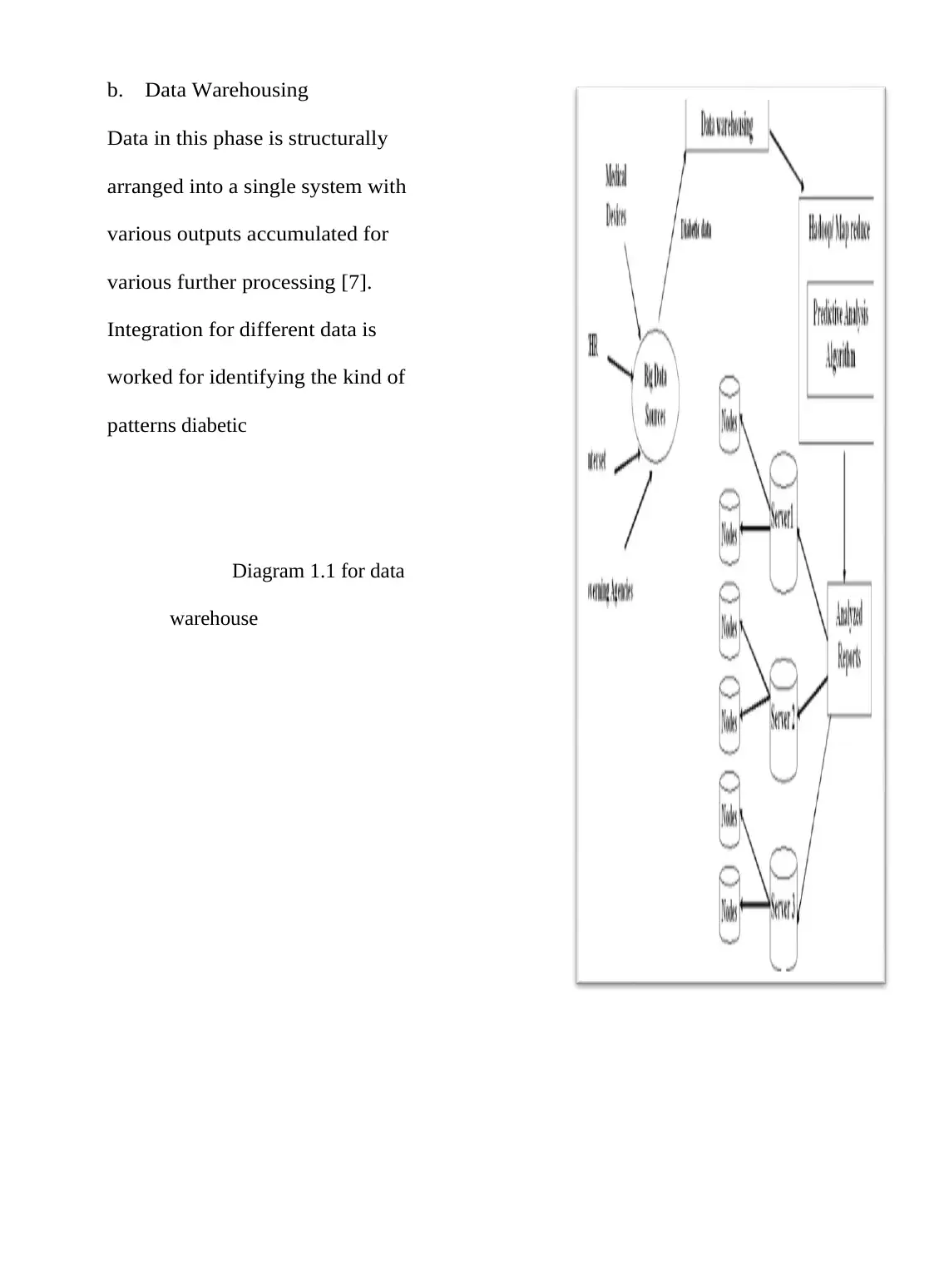
b. Data Warehousing
Data in this phase is structurally
arranged into a single system with
various outputs accumulated for
various further processing [7].
Integration for different data is
worked for identifying the kind of
patterns diabetic
Diagram 1.1 for data
warehouse
Data in this phase is structurally
arranged into a single system with
various outputs accumulated for
various further processing [7].
Integration for different data is
worked for identifying the kind of
patterns diabetic
Diagram 1.1 for data
warehouse

Predictive Analysis
The predictive data analysis assists the
medical physicians with accurate
responses of the results from the
patients. The system provides the ability
for summative financial predictions
estimated by the system. The Hadoop
algorithms are also used for the purpose
of classification of the diabetics and the
kind of treatment provision. The
distribution of data with this system is
obtained from the Apache. The process
involves huge health data through
allocating numerous monitoring servers
such as solving various problems by use
of integration to obtain the final results
[6]. It is asserted that diabetic
medication tests are significant for the
reduction of sugars, glucose regulation,
blood pressure measures, and mass
index of the patients. The predicative
includes the relationship between
diabetic and classification of the health
risks conditions applied for statistical
analytics.
Diagram 1.2 Health data analysis for
diabetics
The model for predictive processing makes the
comparison of variables obtained from the
stored information. The whole process
involves collecting the nodes for structuring.
The nodes contain various predictors
attributing to datasets in the health care
industry [5]. Arguably after the analysis, the
output information for larges data diabetics is
finally distributed to various servers for
replication. Proper electronic communications
The predictive data analysis assists the
medical physicians with accurate
responses of the results from the
patients. The system provides the ability
for summative financial predictions
estimated by the system. The Hadoop
algorithms are also used for the purpose
of classification of the diabetics and the
kind of treatment provision. The
distribution of data with this system is
obtained from the Apache. The process
involves huge health data through
allocating numerous monitoring servers
such as solving various problems by use
of integration to obtain the final results
[6]. It is asserted that diabetic
medication tests are significant for the
reduction of sugars, glucose regulation,
blood pressure measures, and mass
index of the patients. The predicative
includes the relationship between
diabetic and classification of the health
risks conditions applied for statistical
analytics.
Diagram 1.2 Health data analysis for
diabetics
The model for predictive processing makes the
comparison of variables obtained from the
stored information. The whole process
involves collecting the nodes for structuring.
The nodes contain various predictors
attributing to datasets in the health care
industry [5]. Arguably after the analysis, the
output information for larges data diabetics is
finally distributed to various servers for
replication. Proper electronic communications
⊘ This is a preview!⊘
Do you want full access?
Subscribe today to unlock all pages.

Trusted by 1+ million students worldwide
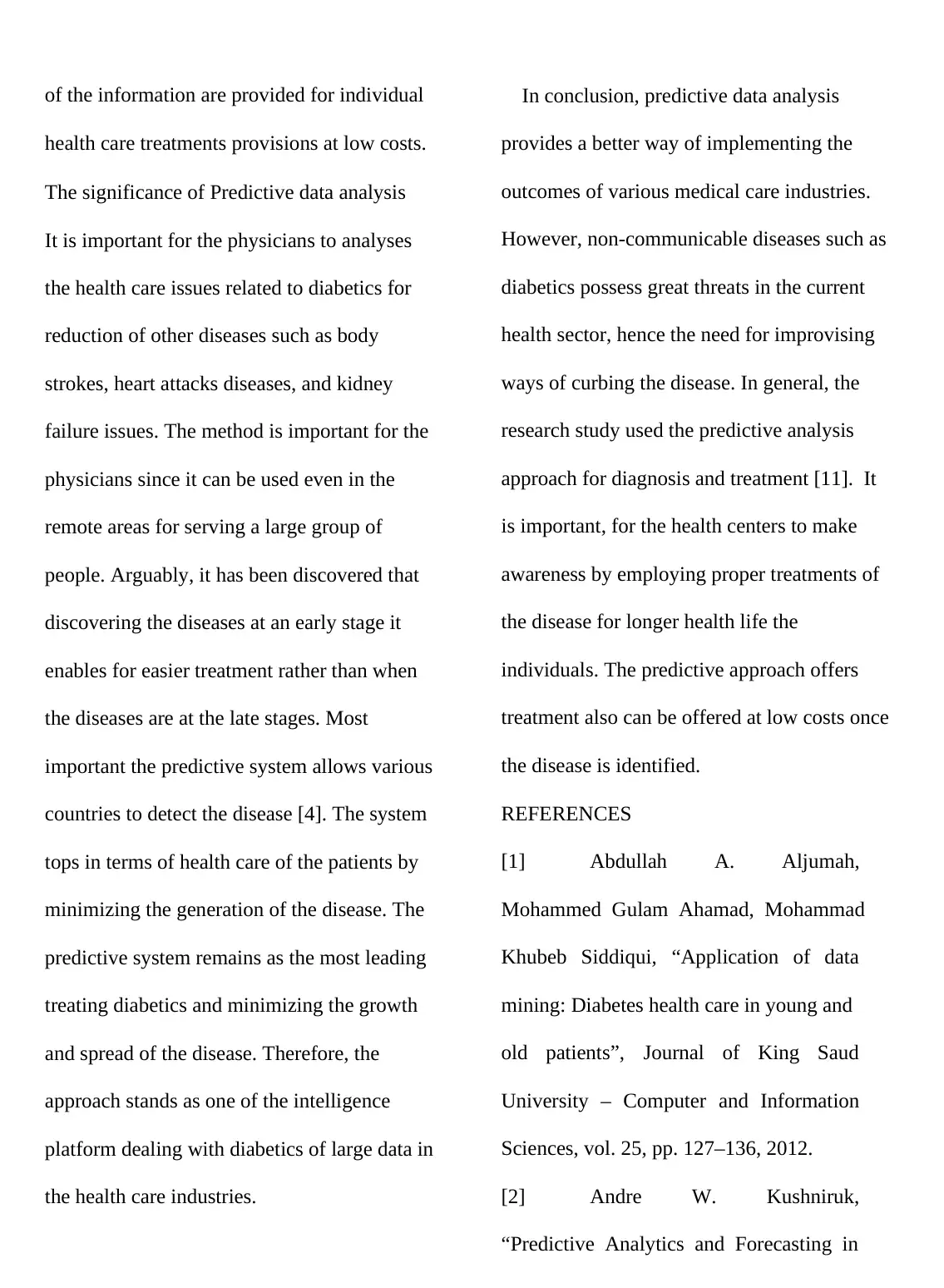
of the information are provided for individual
health care treatments provisions at low costs.
The significance of Predictive data analysis
It is important for the physicians to analyses
the health care issues related to diabetics for
reduction of other diseases such as body
strokes, heart attacks diseases, and kidney
failure issues. The method is important for the
physicians since it can be used even in the
remote areas for serving a large group of
people. Arguably, it has been discovered that
discovering the diseases at an early stage it
enables for easier treatment rather than when
the diseases are at the late stages. Most
important the predictive system allows various
countries to detect the disease [4]. The system
tops in terms of health care of the patients by
minimizing the generation of the disease. The
predictive system remains as the most leading
treating diabetics and minimizing the growth
and spread of the disease. Therefore, the
approach stands as one of the intelligence
platform dealing with diabetics of large data in
the health care industries.
In conclusion, predictive data analysis
provides a better way of implementing the
outcomes of various medical care industries.
However, non-communicable diseases such as
diabetics possess great threats in the current
health sector, hence the need for improvising
ways of curbing the disease. In general, the
research study used the predictive analysis
approach for diagnosis and treatment [11]. It
is important, for the health centers to make
awareness by employing proper treatments of
the disease for longer health life the
individuals. The predictive approach offers
treatment also can be offered at low costs once
the disease is identified.
REFERENCES
[1] Abdullah A. Aljumah,
Mohammed Gulam Ahamad, Mohammad
Khubeb Siddiqui, “Application of data
mining: Diabetes health care in young and
old patients”, Journal of King Saud
University – Computer and Information
Sciences, vol. 25, pp. 127–136, 2012.
[2] Andre W. Kushniruk,
“Predictive Analytics and Forecasting in
health care treatments provisions at low costs.
The significance of Predictive data analysis
It is important for the physicians to analyses
the health care issues related to diabetics for
reduction of other diseases such as body
strokes, heart attacks diseases, and kidney
failure issues. The method is important for the
physicians since it can be used even in the
remote areas for serving a large group of
people. Arguably, it has been discovered that
discovering the diseases at an early stage it
enables for easier treatment rather than when
the diseases are at the late stages. Most
important the predictive system allows various
countries to detect the disease [4]. The system
tops in terms of health care of the patients by
minimizing the generation of the disease. The
predictive system remains as the most leading
treating diabetics and minimizing the growth
and spread of the disease. Therefore, the
approach stands as one of the intelligence
platform dealing with diabetics of large data in
the health care industries.
In conclusion, predictive data analysis
provides a better way of implementing the
outcomes of various medical care industries.
However, non-communicable diseases such as
diabetics possess great threats in the current
health sector, hence the need for improvising
ways of curbing the disease. In general, the
research study used the predictive analysis
approach for diagnosis and treatment [11]. It
is important, for the health centers to make
awareness by employing proper treatments of
the disease for longer health life the
individuals. The predictive approach offers
treatment also can be offered at low costs once
the disease is identified.
REFERENCES
[1] Abdullah A. Aljumah,
Mohammed Gulam Ahamad, Mohammad
Khubeb Siddiqui, “Application of data
mining: Diabetes health care in young and
old patients”, Journal of King Saud
University – Computer and Information
Sciences, vol. 25, pp. 127–136, 2012.
[2] Andre W. Kushniruk,
“Predictive Analytics and Forecasting in
Paraphrase This Document
Need a fresh take? Get an instant paraphrase of this document with our AI Paraphraser
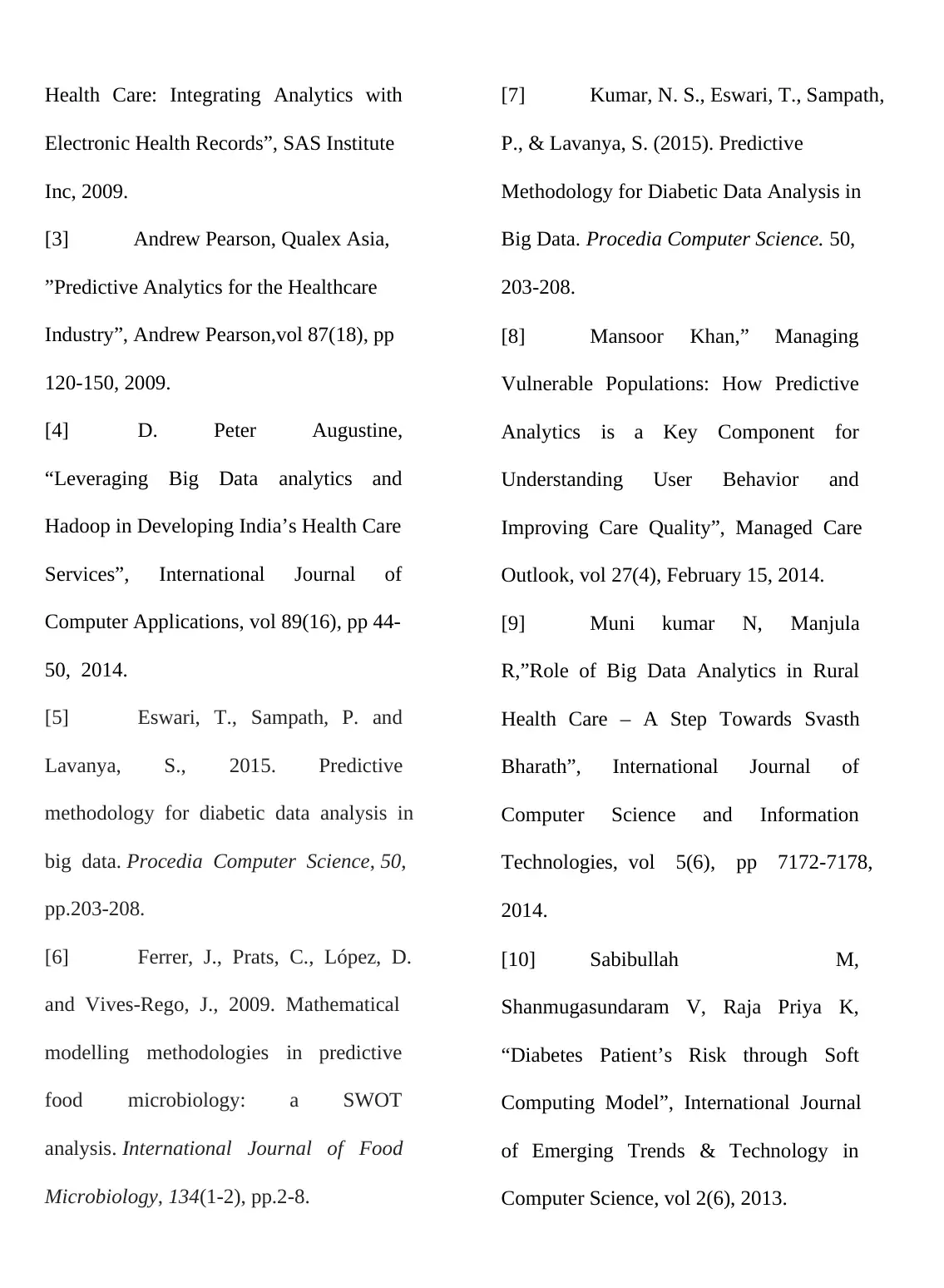
Health Care: Integrating Analytics with
Electronic Health Records”, SAS Institute
Inc, 2009.
[3] Andrew Pearson, Qualex Asia,
”Predictive Analytics for the Healthcare
Industry”, Andrew Pearson,vol 87(18), pp
120-150, 2009.
[4] D. Peter Augustine,
“Leveraging Big Data analytics and
Hadoop in Developing India’s Health Care
Services”, International Journal of
Computer Applications, vol 89(16), pp 44-
50, 2014.
[5] Eswari, T., Sampath, P. and
Lavanya, S., 2015. Predictive
methodology for diabetic data analysis in
big data. Procedia Computer Science, 50,
pp.203-208.
[6] Ferrer, J., Prats, C., López, D.
and Vives-Rego, J., 2009. Mathematical
modelling methodologies in predictive
food microbiology: a SWOT
analysis. International Journal of Food
Microbiology, 134(1-2), pp.2-8.
[7] Kumar, N. S., Eswari, T., Sampath,
P., & Lavanya, S. (2015). Predictive
Methodology for Diabetic Data Analysis in
Big Data. Procedia Computer Science. 50,
203-208.
[8] Mansoor Khan,” Managing
Vulnerable Populations: How Predictive
Analytics is a Key Component for
Understanding User Behavior and
Improving Care Quality”, Managed Care
Outlook, vol 27(4), February 15, 2014.
[9] Muni kumar N, Manjula
R,”Role of Big Data Analytics in Rural
Health Care – A Step Towards Svasth
Bharath”, International Journal of
Computer Science and Information
Technologies, vol 5(6), pp 7172-7178,
2014.
[10] Sabibullah M,
Shanmugasundaram V, Raja Priya K,
“Diabetes Patient’s Risk through Soft
Computing Model”, International Journal
of Emerging Trends & Technology in
Computer Science, vol 2(6), 2013.
Electronic Health Records”, SAS Institute
Inc, 2009.
[3] Andrew Pearson, Qualex Asia,
”Predictive Analytics for the Healthcare
Industry”, Andrew Pearson,vol 87(18), pp
120-150, 2009.
[4] D. Peter Augustine,
“Leveraging Big Data analytics and
Hadoop in Developing India’s Health Care
Services”, International Journal of
Computer Applications, vol 89(16), pp 44-
50, 2014.
[5] Eswari, T., Sampath, P. and
Lavanya, S., 2015. Predictive
methodology for diabetic data analysis in
big data. Procedia Computer Science, 50,
pp.203-208.
[6] Ferrer, J., Prats, C., López, D.
and Vives-Rego, J., 2009. Mathematical
modelling methodologies in predictive
food microbiology: a SWOT
analysis. International Journal of Food
Microbiology, 134(1-2), pp.2-8.
[7] Kumar, N. S., Eswari, T., Sampath,
P., & Lavanya, S. (2015). Predictive
Methodology for Diabetic Data Analysis in
Big Data. Procedia Computer Science. 50,
203-208.
[8] Mansoor Khan,” Managing
Vulnerable Populations: How Predictive
Analytics is a Key Component for
Understanding User Behavior and
Improving Care Quality”, Managed Care
Outlook, vol 27(4), February 15, 2014.
[9] Muni kumar N, Manjula
R,”Role of Big Data Analytics in Rural
Health Care – A Step Towards Svasth
Bharath”, International Journal of
Computer Science and Information
Technologies, vol 5(6), pp 7172-7178,
2014.
[10] Sabibullah M,
Shanmugasundaram V, Raja Priya K,
“Diabetes Patient’s Risk through Soft
Computing Model”, International Journal
of Emerging Trends & Technology in
Computer Science, vol 2(6), 2013.

[11] Venkata Krishna, P., Sasikumar
Gurumoorthy, and Mohammad S. Obaidat.
2019. Internet of things and personalized
healthcare p=5598546.
[12] V. H. Bhat, P. G. Rao, and P. D.
Shenoy, “An Efficient Prediction Model
for Diabetic Database Using Soft
Computing Techniques,” Architecture,
Springer-Verlag Berlin Heidelberg, pp.
328-335, 2009..
Gurumoorthy, and Mohammad S. Obaidat.
2019. Internet of things and personalized
healthcare p=5598546.
[12] V. H. Bhat, P. G. Rao, and P. D.
Shenoy, “An Efficient Prediction Model
for Diabetic Database Using Soft
Computing Techniques,” Architecture,
Springer-Verlag Berlin Heidelberg, pp.
328-335, 2009..
⊘ This is a preview!⊘
Do you want full access?
Subscribe today to unlock all pages.

Trusted by 1+ million students worldwide
1 out of 9
Related Documents
Your All-in-One AI-Powered Toolkit for Academic Success.
+13062052269
info@desklib.com
Available 24*7 on WhatsApp / Email
![[object Object]](/_next/static/media/star-bottom.7253800d.svg)
Unlock your academic potential
Copyright © 2020–2025 A2Z Services. All Rights Reserved. Developed and managed by ZUCOL.





